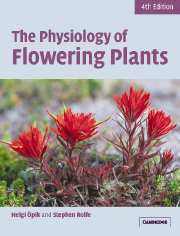Book contents
- Frontmatter
- Contents
- Preface
- Chapter 1 Introduction
- Part I Nutrition and transport
- Part II Growth and development
- Chapter 6 Growth as a quantitative process
- Chapter 7 Plant growth hormones
- Chapter 8 Cell growth and differentiation
- Chapter 9 Vegetative development
- Chapter 10 Photomorphogenesis
- Chapter 11 Reproductive development
- Chapter 12 Growth movements
- Chapter 13 Resistance to stress
- Appendix
- Index
- References
Chapter 7 - Plant growth hormones
Published online by Cambridge University Press: 05 June 2012
- Frontmatter
- Contents
- Preface
- Chapter 1 Introduction
- Part I Nutrition and transport
- Part II Growth and development
- Chapter 6 Growth as a quantitative process
- Chapter 7 Plant growth hormones
- Chapter 8 Cell growth and differentiation
- Chapter 9 Vegetative development
- Chapter 10 Photomorphogenesis
- Chapter 11 Reproductive development
- Chapter 12 Growth movements
- Chapter 13 Resistance to stress
- Appendix
- Index
- References
Summary
Introduction
A constant theme underlying the study of plant physiology is that plant growth and development are controlled by the environment. Plants being sessile organisms, it is not surprising that their development is exquisitely sensitive to a wide range of environmental factors and is extremely plastic, i.e. very flexible. There are underlying basic patterns in plant development, but there is considerable regulation by environmental signals of how and when these patterns are expressed.
In addition, there are internal signals within the plant. One of the most important factors influencing the development of a cell is its position within the plant. A plant cell develops depending on its location in relation to neighbouring cells, and this in turn will determine its response to environmental signals. For example, the response to drought of a cell within the leaf will differ in many ways from that of a cell within the root. The key question arises of how a complex set of environmental factors can interact with cells to elicit an appropriate response within a given cell type: what are the internal signals that communicate between cells, and mediate between environmental factors and the plant tissues?
It has been known for decades (if not centuries) that plants contain a range of compounds which have profound effects on many aspects of growth and developmental physiology, and act as a means of communication within the plant. These plant growth hormones, sometimes referred to as plant growth regulators, are still being discovered.
- Type
- Chapter
- Information
- The Physiology of Flowering Plants , pp. 177 - 204Publisher: Cambridge University PressPrint publication year: 2005



